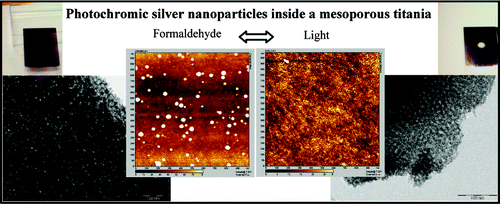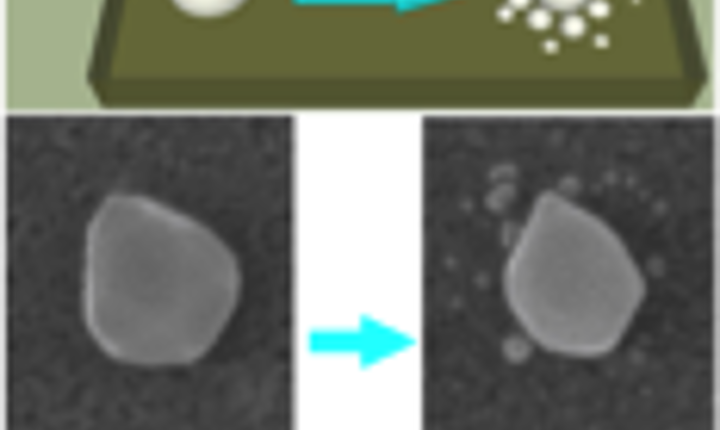Film Nanostructuring & Plasmonic Applications
The work here is centered around optics at the nanoscale. We manipulate surface plasmon dispersion in mesostructured thin films elaborated by sol-gel methods. We aim at elucidating and improving the laser-induced growth and reversible transformations of metal nanoparticles in silica and titania based matrices. We also model the way such nanostructured composite films interact with light to develop photonic applications.
PHOTOCHROMISM
Reversible and Irreversible Laser Microinscription on Silver-Containing Mesoporous Titania Films
Recently, multicolour photochromism has been reported on nanoporous titania films loaded with silver nanoparticles. The change of colour under illumination relies on the control of the nanoparticles size distribution. On the one hand, UV light is used to reduce Ag(I) species and form silver nanoparticles thanks to the photo-induced generation of electrons by the titania matrix. On the other hand, visible light oxidizes the silver nanoparticles via the photoexcitation of electrons on Ag and their stabilization by oxygen molecules. When the nanoparticle size and shape are heterogeneous, the absorption of an incident visible monochromatic light varies from one particle to another and is maximum when the illumination wavelength matches the particle surface plasmon resonance (SPR) wavelength. Therefore, a selective oxidation of some nanoparticles occurs and leads to change the nanoparticles size distribution, which in turn varies the film colour.
Here, we show that silver-containing mesoporous titania films can be used as writable and rewritable data carriers. The permanent and erasable micro-inscriptions are performed with continuous laser beams of various wavelengths under different experimental conditions. We also investigate the irreversible and the reversible mechanisms leading to the non erasable and erasable photoinscriptions, respectively.

Photochromic silver-containing mesoporous titania thin films are used as writable or rewritable data carriers. Continuous wave UV and visible laser radiations, respectively, can either repeatedly print and completely erase micropatterns on their surface or engrave permanent micropatterns, depending on the laser intensity.
Nicolas Crespo-Monteiro,Nathalie Destouches, Laurence Bois, Fernand Chassagneux, Stéphanie Reynaud, Thierry Fournel, Advanced Materials, 22 (29), 3166-3170 (2010)
Chemical Growth and Photochromism of Silver Nanoparticles into a Mesoporous Titania Template
Elaboration of mesoporous titanium oxide film supporting silver nanoparticles is described. Mesoporous titanium oxide films are characterized by TEM analysis. Titania films are infiltrated with a silver salt solution and chemical reduction treatments are performed using either a NaBH4 or a formaldehyde solution. Infiltrated films are then characterized by TEM, SEM, AFM, UV-visible spectroscopy, X-ray diffraction, and Rutherford Backscattering Spectrometry (RBS). The utilization of a mesoporous titania substrate allows to control the nanoparticle size and the interparticle distance. RBS experiments provide the evidence that NaBH4 treatment induces a strong accumulation of silver nanoparticles in the subsurface of the layer, while formaldehyde treatment induces the formation of silver nanoparticles embedded into almost the whole depth of the titania film. Large silver nanocrystals are also formed at the film surface whatever the reducer used. A broad visible absorption band related to the surface plasmon resonance (SPR) is obtained in both cases and is strongly red-shifted compared to the SPR obtained for silver nanoparticles inside a silica matrix. Moreover, irradiation with visible light causes the photooxidation of silver nanoparticles by titania and a complete discoloration of the material. The photooxidation is related to a drastic decrease in the silver nanoparticle size and is found to be reversible, particularly in the case of the material obtained by the formaldehyde reduction.
Laurence Bois, Fernand Chassagneux, Yann Battie, Francois Bessueille, Laurent Mollet, Stephane Parola, Nathalie Destouches, Nelly Toulhoat, and Nathalie Moncoffre, Langmuir, 26 (2), 1199–120 (2010)


